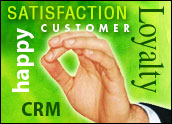
As I’ve said in the past, CRM’s biggest benefit is in extending your customers’relationship with you for as long as you can. New customers are great, but returningcustomers are profitable — and profit is what you’re really after, right?
Thus, it makes sense to foster loyalty in these customers. The first phase ofthis comes in the form of your employees and the relationship they build withcustomers.
Whether it’s a B2B or B2C selling environment, customers would preferto work with people who know them and whom they like. Thus, it’s important thatthose employees care about the niceties of forming relationships on a face-to-faceor phone-to-phone basis.
Backing them up is the CRM system, which serves to institutionalize the knowledgegleaned by your employees in face-to-face interactions and in other, more easilyautomated and recorded interactions.
With that one-two punch, you’re well equipped to launch a loyalty program, whichmakes it a bit astounding when you see many of these efforts in action.
What’s in a Name?
For example, one business I buy from weekly solicits me with offers via emailsaddressed to “Curis.” I know what’s happened — whoever was put in charge ofdata entry for this particular marketing effort simply missed the letter “H” and hit”U” instead. But the people at the store know me by sight and by name; trying toenhance my loyalty by addressing me by a typographical error is actually a stepbackward.
So is a lack of responsiveness to my repeated attempts to correct thespelling. In the grand scheme, “Curis” is not a deal-breaking typo, but it suggests alack of care about me as a customer. This is not what you should engender through aloyalty program.
Another example: At a business I frequent, a cadre of regular customers haslong been given a 10 percent discount at the counter. The staff knows that we’reessentially live-action “super users,” the kinds of customers whom the staff can ask tohelp other customers. As we’re shopping, we’re actually augmenting their staff — andthe staff knows and appreciates that.
Giving the 10-percent discount was a nice touch. Then the business decided to offer a”loyalty card” that allowed you to build up “points” toward a discount with yourpurchases. Hey, wait a minute — you’re saying that all my previous purchases, plusmy assistance to fellow customers, has now been wiped away and I have to earnmy way back to a status I already held? And the discount, once I earn it, will be lessthan 10 percent?
How is this supposed to make me loyal? Isn’t it more likely to make me disloyal, because it’s clear evidence of how the business is disregarding my pastloyalty by starting me back at zero?
Efforts like this loyalty card work well if your business has just started. In mostcases, however, these programs debut after a business has some history, somecustomers, and some history with certain customers.
3 Big Don’ts
If you’re trying to boost loyalty, here are three suggestions:1. Don’t go back on offers you’ve made to loyal customers.
If you offer something as a show of gratitude toward loyal customers, and you’reclear about it being an ongoing offer, revoking it summarily suggests the opposite:You no longer have that gratitude.
It may be easier for the business to do away withearlier offers in the course of implementing a new loyalty effort. However, it’s noteasier for the customers who benefited from that earlier program. It’s frustratingand confusing, two things that will provide emotional impetus for them to buy fromsomeone else.
2. Don’t create conditions for new loyal customers that are less attractive than whatyou’ve offered past loyal customers.
It makes sense to treat different buyers in different ways; regular customers whospend a lot should get better treatment than regular customers who spend a little,for instance. Don’t set up a situation where similar customers receive differentrewards, though. This can happen when customers are identified as worthy of retentionat different times.
The problem here is that customers talk to each other — andexplaining that one customer gets a better discount than another solely becauseof the date at which the entered a loyalty program suggests you’re treating thesevaluable customers in an arbitrary fashion — mostly because that’s exactly whatyou’re doing.
3. Don’t get complicated.
Don’t create a loyalty program that turns the customers’ participation into a job.In other words, don’t turn the program into something confusing or complicated,because your customers don’t want to have to work to be recognized for theirloyalty.
They also deserve to have the same expectations that you have. Acomplicated program with points structures, expiration dates and qualifyingconditions is likely to create confusion that leads to conflict. Why would you want toengender conflict with your loyal customers? That runs exactly counter to the entirepoint of rewarding loyalty.























































Social CRM
See all Social CRM